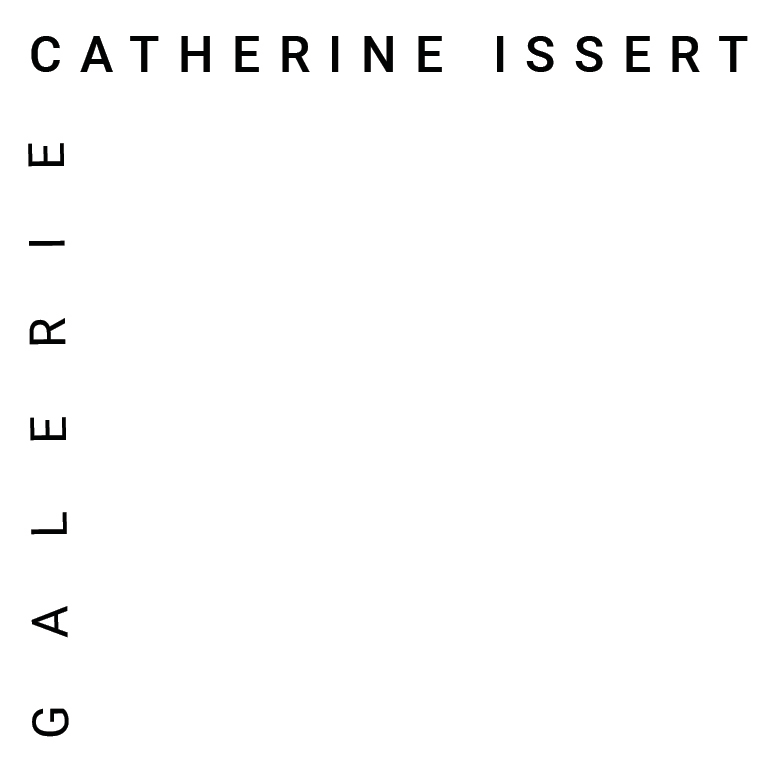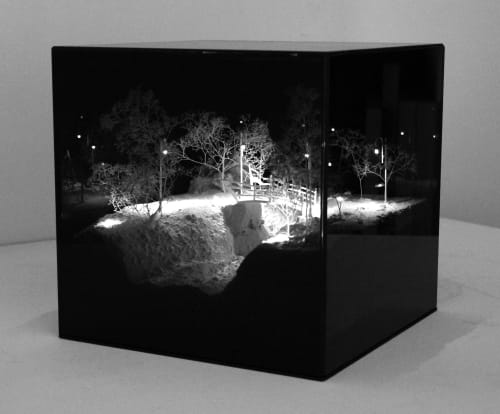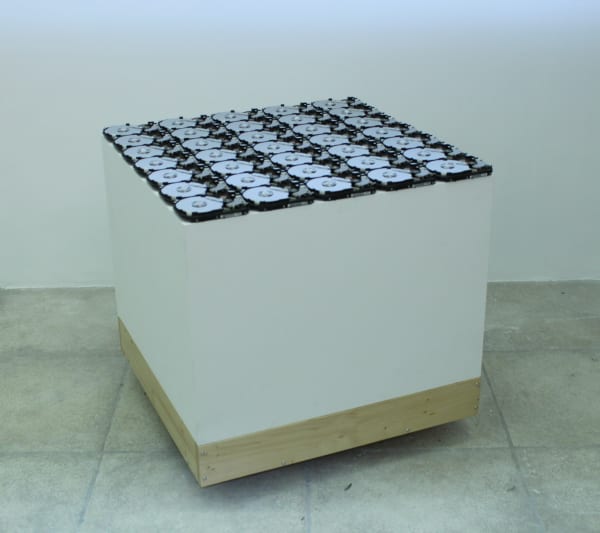Mathieu SCHMITT: LMY, MY, MY, DELILAH
La galerie Catherine Issert présente la première exposition personnelle de Mathieu Schmitt.
Faute de frappe dans le titre d’un article paru dans le New Scientist, « Lmy, My, My Delilah » fait réfé- rence à la fois à la célèbre chanson de Tom Jones « My, my, my Delilah » et au système avancé de discours sécurisé inventé par Alan Turingen 1943, DELILAH. Cette«coquille»rend certes le clin d’œil musical laborieux, mais génère dans le même temps une séquence rappelant le système de fonctionne- ment de la machine de Turing elle-même. Un hasard, une erreur de rien du tout. Sauf que ...
Mathieu Schmitt construit une pratique pluridisciplinaire dans laquelle l’interprétation des signaux (informatiques, électriques, radios, ...) dans leur fonctionnalité, leur potentialité et leur faillibilité jouent un rôle majeur.
Au travers d’œuvres comme Glitched, 35 Hard Drive Speakers Playing The Voice Record Of Their Own Title Expanded To The Length Of The Exhibition, Cadavres exquis, Selfconsciousness et Oui Ja, il explore la dysfonction et le détournement du signal virtuel.
Ici, Heinz Von Foerster, père de la cybernétique, dialogue avec Merleau-Ponty, père de la phénoménolo- gie. Car Mathieu Schmitt actualise notre environnement sensible en y incluant l’intelligence artificielle, qu’il traite comme un phénomène à part entière et non pas uniquement comme un système mathématique.
Dans une vision transhistorique, Mathieu Schmitt joue également avec les codes de l’art, du design et de l’architecture, en réinterprétant notamment le minimalisme, l’abstraction et l’art conceptuel. Les références sont ici des signes plastiques que l’artiste combine pour obtenir des méta-œuvres : Armle- der rencontre Duchamp qui dialogue avec Morellet qui questionne le Corbusier, etc ... Cela s’exprime au travers d’œuvres comme Sport Elec Architectures, Intérieurs froissés, Unpacked LC2,Topless, Escape From Morellet ou bien encore Composition Fonctionnelle.
Mathieu Schmitt semblerait donc percevoir son environnement créatif comme un algorithme, une suite finie d’opérations ou d’instructions permettant de résoudre un problème : il n’en est rien.
Car l’artiste aime gripper sa propre machine : en introduisant l’erreur, le bug, le glitch de manière volon- taire dans son processus créatif, il produit des œuvres dans lesquelles il laisse place à la poésie, au mys- tère et à l’esthétique, un univers « para et post humain ».
Pauline THYSS
_______________________________________
A typing error in the title of an article published in the New Scientist, «Lmy, My, My Delilah» recalls both the famous hit by Tom Jones «My, my, my Delilah» and the advanced secure speech system invented by Alan Turing in 1943, DELILAH. The typo certainly renders the musical refe- rence somewhat laborious, but simultaneously triggers a sequence recalling the way in which Turing's machine actually worked itself. A matter of chance, a little mistake. Except that... Mathieu Schmitt pursues a multi-disciplinary approach in which the interpretation of signals (computer, electrical, radio...) in all their functional, potential and fallible aspects plays a major role.
In works such as Glitched, 35 Hard Drive Speakers Playing The Voice Record Of Their Own Title Expanded To The Length Of The Exhibition, Cadavres exquis, Selfconsciousness and Oui Ja, he explores the malfunctioning and appropriation of the virtual signal.
Here, Heinz von Foerster, father of cybernetics, interacts with Merleau-Ponty, father of pheno- menology. For Mathieu Schmitt up-dates our sentient environment by introducing artificial intelligence, which he treats as a phenomenon in its own right rather than as a mathematical system.
In his trans-historic vision, Mathieu Schmitt also plays with codes of art, design and architecture, re-interpreting, for instance, minimalism, abstract and conceptual art.The references here consist of plastic signs that the artist combines to obtain meta-works : Armleder encounters Duchamp who converses with Morellet who asks questions of Le Corbusier etc... This takes the form of works such as Sport Elec Architectures, Intérieurs froissés, Unpacked LC2, Topless, Escape From Morellet and Composition Fonctionnelle.
Mathieu Schmitt would thus seem to perceive his creative environment as an algorithm, a finite series of operations or instructions enabling him to solve a problem: but such is not the case. For the artist likes to jam his own machine: by voluntarily introducing an error, a bug, a glitch into his creative process, he produces works in which he leaves room for poetry, mystery and esthetics, a world both «para- and post-human».
Pauline THYSS















